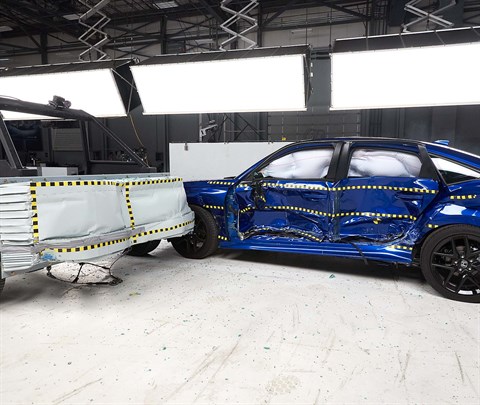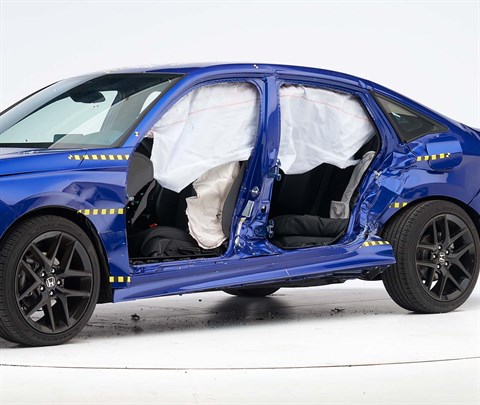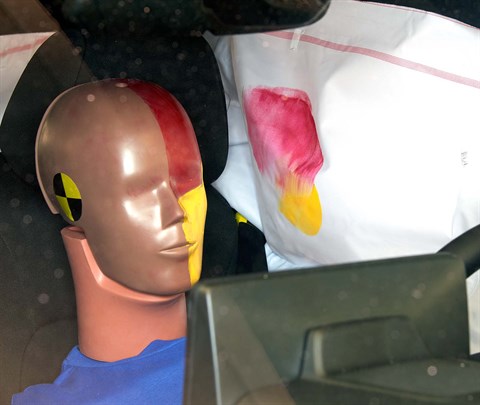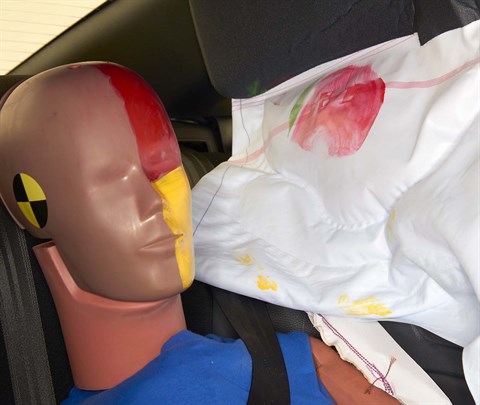Small overlap front: driver-side
Rating applies to 2022-25 models
Tested vehicle: 2022 Honda Civic 1.5T Touring 4-door
The Honda Civic was redesigned for the 2022 model year. Driver-side small overlap frontal ratings are assigned by the Institute based on a test of a 2022 Civic sedan conducted by Honda. The ratings also apply to the 4-door hatchback version of the Civic, also redesigned for the 2022 model year.
| Evaluation criteria | Rating |
|---|---|
| Structure and safety cage | |
| Driver injury measures | |
| Head/neck | |
| Chest | |
| Hip/thigh | |
| Lower leg/foot | |
| Driver restraints and dummy kinematics | |
Small overlap front: passenger-side
Rating applies to 2022-25 models
Tested vehicle: 2022 Honda Civic 1.5T Touring 4-door
The Honda Civic was redesigned for the 2022 model year. Passenger-side small overlap frontal ratings are assigned by the Institute based on a test of a 2022 Civic sedan conducted by Honda. The ratings also apply to the 4-door hatchback version of the Civic, also redesigned for the 2022 model year.
| Evaluation criteria | Rating |
|---|---|
| Overall evaluation | |
| Structure and safety cage | |
| Passenger injury measures | |
| Head/neck | |
| Chest | |
| Hip/thigh | |
| Lower leg/foot | |
| Passenger restraints and dummy kinematics | |
| Driver injury measures | |
| Head/neck | |
| Chest | |
| Hip/thigh | |
| Lower leg/foot | |
|
Driver restraints and dummy kinematics
The dummy’s head contacted the frontal airbag but nearly rolled off the right side, leaving the head vulnerable to contact with forward structure. Additionally, the seat belt allowed excessive forward excursion of the dummy’s head and torso. | |
Moderate overlap front: original test
Rating applies to 2022-25 models
Tested vehicle: 2022 Honda Civic 1.5T Touring 4-door
The Honda Civic was redesigned for the 2022 model year. Moderate overlap frontal ratings are assigned by the Institute based on a test of a 2022 Civic sedan conducted by Honda. The ratings also apply to the 4-door hatchback version of the Civic, also redesigned for the 2022 model year.
| Evaluation criteria | Rating |
|---|---|
| Overall evaluation | |
| Structure and safety cage | |
| Driver injury measures | |
| Head/neck | |
| Chest | |
| Leg/foot, left | |
| Leg/foot, right | |
| Driver restraints and dummy kinematics | |
Side: original test
Rating applies to 2022-24 models
Tested vehicle: 2022 Honda Civic 2.0L LX 4-door
The Honda Civic was redesigned for the 2022 model year. Side ratings are assigned by the Institute based on a test of a 2022 Civic sedan conducted by Honda. The ratings also apply to the 4-door hatchback version of the Civic, also redesigned for the 2022 model year.
| Evaluation criteria | Rating |
|---|---|
| Overall evaluation | |
| Structure and safety cage | |
| Driver injury measures | |
| Head/neck | |
| Torso | |
| Pelvis/leg | |
| Driver head protection | |
| Rear passenger injury measures | |
| Head/neck | |
| Torso | |
| Pelvis/leg | |
| Rear passenger head protection | |
Side: updated test
Rating applies to 2022-24 models
Tested vehicle: 2022 Honda Civic Sport 4-door sedan
The Honda Civic was redesigned for the 2022 model year. The ratings also apply to the 4-door hatchback version of the Civic, also redesigned for the 2022 model year.
| Evaluation criteria | Rating |
|---|---|
| Overall evaluation | |
| Structure and safety cage | |
| Driver injury measures | |
| Head/neck | |
| Torso | |
| Pelvis | |
| Driver head protection | |
| Rear passenger injury measures | |
| Head/neck | |
| Torso | |
| Pelvis | |
| Rear passenger head protection | |

View of the vehicle just after the crash test.

View of the vehicle after the crash with doors removed, showing the side airbags and damage to the occupant compartment.

Smeared greasepaint shows where the driver dummy's head was protected from being hit by hard structures by the side airbags.

Smeared greasepaint shows where the rear passenger dummy’s head was protected by the side airbags.
Roof strength
Rating applies to 2022-23 models
Tested vehicle: 2022 Honda Civic 2.0L LX 4-door
Rating applies to both the Civic 4-door sedan (tested) and 4-door hatchback versions.
| Overall evaluation | |
|---|---|
| Curb weight | 2,845 lbs |
| Peak force | 21,689 lbs |
| Strength-to-weight ratio | 7.62 |
Head restraints & seats
Seat type: Manual cloth seat
| Overall evaluation | |
|---|---|
| Dynamic rating | |
| Seat/head restraint geometry |
About the head restraint & seat test
Currently, IIHS tests apply only to front seats.
Headlights
Trim level(s)
- All trims
| Evaluation criteria | Rating |
|---|---|
| Low-beam headlight type | LED reflector |
| High-beam headlight type | LED reflector |
| Curve-adaptive? | No |
| High-beam assist? | Yes |
|
Overall rating | |
| Distance at which headlights provide at least 5 lux illumination: | |
Low beams
On the straightaway, visibility was good on both sides of the road. On curves, visibility was good in all 4 tests.
The low beams created some glare.
High beams
On the straightaway, visibility was good on the right side of the road and fair on the left side. On curves, visibility was good in all 4 tests.
High-beam assist compensates for some limitations of this vehicle's low beams on the gradual left curve.
